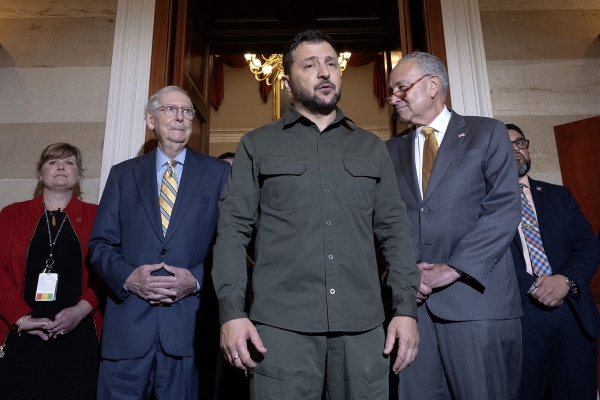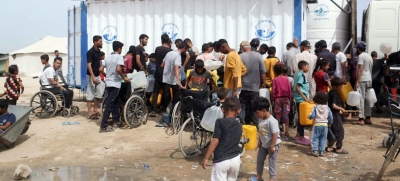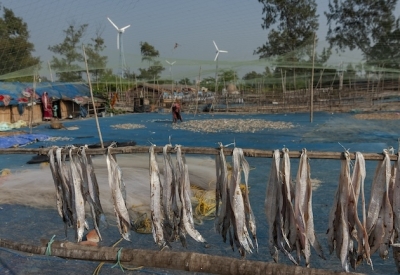Ukrainian President Volodymyr Zelenskyy is visiting the White House and Congress on Thursday — but under decidedly different circumstances than when he arrived less than a year ago.
Zelenskyy is seeking to shore up support as Ukraine is struggling to achieve a breakthrough in its counteroffensive. The objective Ukraine is targeting — to essentially divide up Russian-controlled territory — was always going to be extremely challenging. And now time is running short, as fall turns to winter, when fighting will become much more difficult. At the same time, Russia has continued bombarding Ukraine, overnight unleashing missiles on major cities like Kyiv and Kharkiv, and even Lviv, in the west, far from the front lines. Those attacks damaged energy infrastructure, an echo of Moscow’s campaign last year to try to undermine Ukraine’s economy and its population’s resolve.
Russia’s invasion continues, as does the suffering and devastation that it has wrought. That hasn’t changed, but the future trajectory of the conflict is a lot less clear — which is why Zelenskyy, after trying to rally the world to Ukraine’s cause at the United Nations in New York, is meeting face-to-face with his backers in Washington.
That may be the biggest difference from last year: the question-mark over future Western support for Ukraine, and what that might mean for Ukraine’s ability to sustain its defense against Russia. On the whole, the United States and Europe have continued to provide financially and militarily to Ukraine. Yet the splits are beginning to show. It’s not clear how big or significant they will be, but Zelenskyy doesn’t want to reach the point where Ukraine has to find out.
The political dynamics abroad may change the course of war in Ukraine
When Zelenskyy visited Washington last December, Congress was considering another huge billion-dollar package of aid to Ukraine. This time, the Biden administration is pushing Congress to pass another $24 billion in aid to Ukraine. Then, as now, the package has bipartisan support, save for a vocal group of Republicans who have criticized the “blank check” to Kyiv.
That assistance package did pass last year, but the skepticism of Ukraine aid has intensified among this set of Republicans. They are questioning Ukraine’s counteroffensive progress against Russia, and where all this money is going. This has also become a leverage point in the GOP’s internal feud that could shut down the US government.
Some House Republicans remain optimistic; Michael McCaul (R-TX), the House chair of the Foreign Affairs Committee, said Thursday that “we will get it done.”
But even if this Ukraine aid package does get done, it will likely come after more short-term drama, and maybe even a government shutdown, which is probably not going to make any partners who rely on the US confident about its reliability.
And Zelenskyy apparently made no secret to lawmakers as to how much Kyiv relies on that support. As Senate Majority Leader Chuck Schumer (D-NY) said in Thursday floor remarks: “To quote President Zelenskyy in the room, and this is a quote, he said: ‘If we don’t get the aid, we will lose the war.’ That’s a quote from President Volodymyr Zelenskyy. That’s how stark the issue is.”
This funding request is also not likely the last US political hurdle for Ukraine. The GOP primary debates have showcased the views of Ukraine skeptics, including the frontrunner, Donald Trump, who claims he has a plan to end the war. This strain in the GOP, then, is probably not going away, and may morph beyond battles over Ukraine funding into fundamentally questioning the US’s position on Ukraine. As Zelenskyy said in an interview this week, if Trump has a peace plan, he should share it. But, Zelenskyy added: If “the idea is how to take the part of our territory and to give Putin, that is not the peace formula.”
There are also some worrisome signs among Ukraine’s other partners. Western solidarity has not been perfect throughout Russia’s invasion, but it’s largely held up amid domestic political fights, an energy crisis, and inflation. But none of that is permanent.
Right now, Poland, Hungary, and Slovakia have defied EU rules and banned Ukrainian grain exports, saying they are flooding the market and undermining their farmers. Ukraine has filed a complaint at the World Trade Organization against that move, including against Poland, perhaps Kyiv’s staunchest supporter in the Western alliance to date.
On Thursday, Poland’s prime minister said it was done sending weapons to Ukraine amid this grain dispute. It’s not clear exactly how the policy will play out; US National Security Advisor Jake Sullivan said Thursday that he believes that Poland continues to stand behind Ukraine. But it shows that support for Ukraine is not unconditional.
At the heart of this feud, too, is Russia’s withdrawal from the Black Sea grain deal and its continued blockade of the Black Sea. Ukraine is still trying to get grain out through its sea ports, but it is risky, especially as the region becomes an increasingly volatile front in the war. But Russia can continue to use this as a pressure point, strangling Ukraine’s economy, probing a sore spot in Ukrainian-Polish relations, and potentially disrupting global food prices.
And right now, it seems Russia can continue to expose these pressure points.
The conflict feels entrenched right now, but the stakes are as high as ever
At the United Nations, Zelenskyy called on the world to “act united to defeat the aggressor.” Soon after, Moscow unleashed an aggressive air campaign against Ukrainian cities. Russia almost seemed to be sending a message: Try us.
Russia is not exactly winning, but it is also not defeated. Its winter offensive largely failed to achieve its objectives, and there are plenty of doubts as to whether Russia is capable of trying another offensive next year. But Moscow’s defensive lines proved formidable against Ukraine’s advances. Kyiv may be degrading Russian forces and logistics, but Moscow also has tools Ukraine doesn’t have, like the ability to pound Ukrainian forces from the air with attack drones and guided bombs, straining Ukraine’s air defense capabilities and exploiting Kyiv’s lack of air superiority.
Russia probably wouldn’t be calling up North Korea if it didn’t really need more munitions and weapons, and sanctions will continue to deplete its ability to wage war in the long-term. But Russia is still finding ways to fight, and even seeking to retake some territory as Ukraine focuses on its counteroffensive. President Vladimir Putin has, so far, survived the biggest challenge to his power to date, and then that challenger’s plane fell out of the sky — a sign, at least for now, that Putin is still in control and will continue waging his war.
Yet Ukrainian forces could still make a decisive push into Russian territory in the coming weeks. Last September, Ukraine liberated huge swaths of Kharkiv, and later, in November, forced a Russian retreat in Kherson. That momentum bolstered Western support, and, maybe, along with that Zelenskyy visit, helped convince the West to provide Kyiv things like missile defense systems and battle tanks.
Kyiv has adapted and changed throughout the conflict, because it knows the stakes of this war, which are existential. Kyiv switched tactics in its summer counteroffensive when its initial blitz failed, and Ukrainian troops have had success — and might have more still — degrading Russian forces. Ukraine is developing capabilities to take the fight directly to Moscow, with drones and sabotage operations. This is the case Zelenskyy is making in Washington: that Ukraine can win, and it will win. But Kyiv’s backers have to stay the course.






